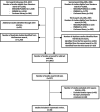The mechanism of hamstring injuries - a systematic review
- PMID: 32993700
- PMCID: PMC7526261
- DOI: 10.1186/s12891-020-03658-8
The mechanism of hamstring injuries - a systematic review
Abstract
Background: Injuries to the hamstring muscles are among the most common in sports and account for significant time loss. Despite being so common, the injury mechanism of hamstring injuries remains to be determined.
Purpose: To investigate the hamstring injury mechanism by conducting a systematic review.
Study design: A systematic review following the PRISMA statement.
Methods: A systematic search was conducted using PubMed, EMBASE and the Cochrane Library. Studies 1) written in English and 2) deciding on the mechanism of hamstring injury were eligible for inclusion. Literature reviews, systematic reviews, meta-analyses, conference abstracts, book chapters and editorials were excluded, as well as studies where the full text could not be obtained.
Results: Twenty-six of 2372 screened original studies were included and stratified to the mechanism or methods used to determine hamstring injury: stretch-related injuries, kinematic analysis, electromyography-based kinematic analysis and strength-related injuries. All studies that reported the stretch-type injury mechanism concluded that injury occurs due to extensive hip flexion with a hyperextended knee. The vast majority of studies on injuries during running proposed that these injuries occur during the late swing phase of the running gait cycle.
Conclusion: A stretch-type injury to the hamstrings is caused by extensive hip flexion with an extended knee. Hamstring injuries during sprinting are most likely to occur due to excessive muscle strain caused by eccentric contraction during the late swing phase of the running gait cycle.
Level of evidence: Level IV.
Keywords: Biomechanics; Muscle injury; Running; Sprinting; Strength.
Conflict of interest statement
None declared.
Figures
References
-
- Roe M, Murphy JC, Gissane C, Blake C. Hamstring injuries in elite Gaelic football: an 8-year investigation to identify injury rates, time-loss patterns and players at increased risk. Br J Sports Med. 2016;52(15):982–8. - PubMed
Publication types
MeSH terms
LinkOut - more resources
Full Text Sources
Medical
Research Materials



